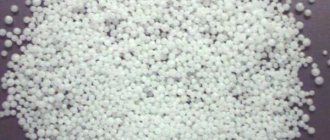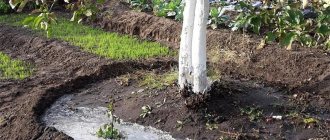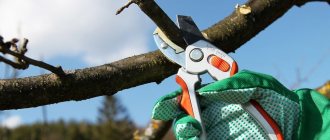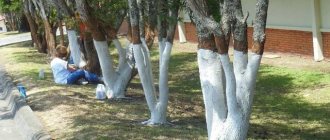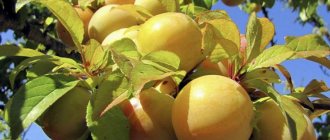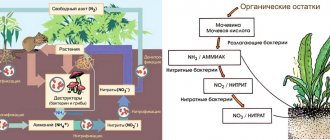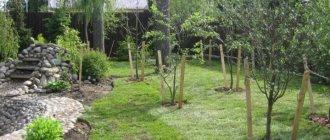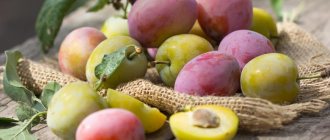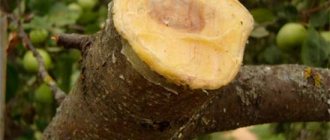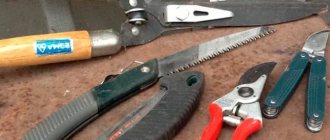About the importance of spring feeding
During the growing season, plants absorb many nutrients from the soil. The soil, losing fertility, requires constant fertilizing. It is especially important to provide nutrition in the spring, when plants need to rapidly increase their green mass, grow and develop.
Thanks to spring feeding:
- plant growth is activated;
- productivity increases;
- the taste of fruits improves;
- plants look more attractive;
- the leaves look healthy, rich green, without spots or paleness;
- immunity increases.
Types of fertilizing
All fertilizers used to feed plants are divided into two groups - organic and mineral.
Fruit trees must receive in the spring:
- nitrogen – is responsible for the growth of green mass;
- phosphorus – the strengthening and development of the root system depends on it, it is also responsible for metabolic processes;
- potassium – thanks to this element, plant immunity increases.
Stone fruit crops require fewer nutrients than pome crops.
Trees and shrubs need boron, iron, copper, zinc, cobalt and molybdenum.
Organic
In spring, trees and shrubs can be fed:
- manure;
- bird droppings;
- compost;
- humus;
- peat.
Mulching with fallen leaves, straw, and sawdust also gives a good effect. By rotting, mulch nourishes the soil with useful elements.
Effect of adding organic matter:
- saturates the soil with nutrients;
- improves soil structure;
- activates soil microflora.
The most affordable and universal fertilizer suitable for almost all garden crops is compost.
Thanks to compost, fruit trees better absorb micro- and macroelements. Other benefits of compost:
- no toxic compounds;
- is able to restore the fertility of the poorest soils;
- has a positive effect on the health, growth and immunity of plants.
Mineral
Inorganic fertilizers differ from organic ones in higher concentration. They are:
- Simple. They contain one main component - nitrogen, phosphorus or potassium.
- Complex. They contain 2 or 3 main components.
In spring, trees and shrubs are fed:
- Nitrogen fertilizers. Apply in early spring. In order not to provoke an excessively rapid growth of green mass, it is important to follow the dosage. Add: ammonium sulfate;
- ammonium nitrate;
- urea
- potassium magnesia;
Mineral fertilizers - dry granules, are scattered around the tree trunks. Gradually, during watering, the granules dissolve, enriching the soil.
Feeding fruit trees during and after flowering
Feeding fruit trees and shrubs in spring
If spring fertilizing is aimed at strengthening the health and immunity of fruit and berry crops, then summer fertilizing is aimed at increasing productivity. Feeding fruit trees in summer involves applying organic matter and complex mineral fertilizers. First of all, potassium fertilizers, as well as universal preparations from the azofoska series, are important for fruiting. Its complex composition will provide the entire set of essential vitamins.
The process of feeding trees and shrubs has its own characteristics. For trees, there are three methods:
- root;
- foliar;
- spraying.
The first method is not suitable for shrubs, since their roots are located close to the surface of the earth and are easily damaged. The latter does not apply to watering with fertilizers at the roots.
Feeding with ash
For trees, the root feeding method involves removing the soil near the trunk, adding a mixture of manure, peat, soil and fertilizer, and then covering it again with the removed soil. Some gardeners add ash, sand, and yeast to such compositions. After the removed soil is returned to its place, urea is added after 2-3 days. It accelerates the breakdown process of fertilizers and enhances their effect.
Fertilizing in the summer is characterized by the fact that it is carried out at different times for each crop. The latter can be divided into:
- early fruiting fruit crops;
- mid-early crops;
- late fruiting crops.
Basically, the same fertilizer complexes are chosen for them, but the procedures are carried out at different times. The total number of summer feedings should not exceed 3-5 times, depending on the variety, type and age of the tree or shrub.
Important! For early fruiting crops, you should choose phosphorus-potassium fertilizers in a percentage of the main substance of at least 50%. During the flowering period, it is recommended to feed cherries, cherries, peaches, apricots and plums with such complexes.
Their flowering period is in June, which means you can feed the trees as early as May. Phosphorus is important in the formation of flower buds and, in fact, the yield of the crop depends on it. In addition, if we are talking about apricots and peaches, the fruit will be stored longer, since phosphorus increases shelf life. Potassium promotes the absorption of nitrogen from the soil and also increases the winter hardiness of the crop.
The most convenient time for applying fertilizers will be the first week of May. During this period, you can use the root method without fear.
Feeding is done as follows:
- the turf, if any, is removed around the tree trunk;
- half a meter from the base of the trunk, dig small holes so that they almost reach the rhizome (up to 7 such holes can be made);
- Fertilizer granules, one handful of potassium and phosphorus, are placed in each hole;
- they must be mixed with soil and watered;
- Fill the holes back and cover with turf.
This method is recommended when the seedling is transferred to the ground or transplanted to a permanent place. Early varieties of apple and pear trees are also fed.
During the flowering period, early fruiting crops should be fed with organic matter. It could be compost. Nitrogen fertilizers will be useful, especially for apple, quince, pear, and plum trees.
Shrubs also need to be fertilized during the flowering period: currants, gooseberries, camentoza or felt cherries. Superphosphates and organic matter are also relevant for these crops.
When do you feed trees?
There are no exact dates for fertilizing. It is necessary to focus on weather conditions. In the southern regions, fertilizing is applied earlier - around the beginning of March, in other regions later.
There are three periods of fertilization, and each of them has its own characteristics.
First feeding of fruit trees
The first feeding is carried out in the snow or later. There is no general opinion on this matter. Gardeners argue when to fertilize:
- In early spring. When the snow has not yet completely melted, fertilizers are scattered directly over the melting snow. The method does not allow the application of precise doses - part of the fertilizer is carried away with meltwater. Only mineral fertilizers are applied in this way. Nitrogen-containing granules are scattered directly in the tree trunk circles - across the entire width of the crown. Nitrogen dissolves in melt water and seeps deep into the soil. If there is a lot of snow and the ground has not thawed, there is no need to rush - the granules will lie on the snow for a long time, losing nitrogen.
- During the period of bud break. Most amateur gardeners believe that it is better to apply fertilizers during the awakening period of plants - when the buds begin to bloom. If nitrogen was not applied through the snow, then it is applied during this period.
An adult fruit tree requires 100-120 g of nitrogen-containing fertilizer - 2-3 handfuls of granules are scattered around the tree trunk. Young trees are given 35-40 g.
An overdose of nitrogen during spring feeding can provoke fungal diseases.
Second feeding of fruit trees
The second feeding is carried out during flowering. They add phosphorus and potassium, which are responsible for the formation of ovaries and fruits. Experienced gardeners advise adding these elements separately. First, phosphorus is added, depending on the region - in April-early May, and then potassium.
Features of feeding:
- It is not recommended to add phosphorus and potassium together.
- In the first two weeks of April, plants are fed with phosphorus fertilizers (superphosphate) - 50-60 g per adult plant, 30 g per young seedling.
- It is not recommended to add potassium in its pure form. It is advisable to use complex mixtures - potassium magnesium, potassium sulfate, potassium salt, stove ash. An adult tree requires 20-25 g of fertilizer. Seedlings are given half the dose.
Third and fourth feedings
The third and fourth feeding is carried out after flowering. Such fertilizing is not done every spring, but once every two years, if the soil is fertile. Poor soils are fed with organic matter annually.
When the trees and shrubs fade, the soil is fertilized with organic matter - it is added for digging, or weed infusions. Suitable for feeding:
- dandelions;
- nettle;
- wheatgrass;
- sow thistle;
- chamomile;
- reed;
- spurge;
- sedge;
- burdock;
- comfrey.
How to prepare an infusion of herbs for feeding:
- Finely chop any of the herbs listed above.
- Place the chopped herbs in a barrel and fill with water.
- Add 10 ml of humate per 50 liters of mixture. It will promote fermentation.
- Leave for a week, stir the mixture from time to time.
- Strain the infusion and dilute it with water 1:10.
The last, fourth feeding occurs at the beginning of fruiting. Recommended use:
- humus;
- compost;
- vermicompost.
For the fourth feeding, you can also use complex mixtures.
Feeding by month
It is important to apply any fertilizer to trees in the spring, taking into account the needs of each crop and climate characteristics.
The first treatment is planned for March. Soluble fertilizers are scattered on the snow so that during melting the beneficial substances are absorbed into the soil. Young trees and shrubs need 40 g of fertilizer; adults will need about 100 g. An excess of nitrogen will weaken the immune system, and the trees will be susceptible to fungal diseases.
In April, leaves form and flowering begins. Fertilizers for fruit trees in the spring with potassium and phosphorus will be most effective. Phosphorus will strengthen the root system and ensure its growth. Potassium is responsible for the formation of side shoots.
In May, when the tree is actively blooming, it is allowed to use both minerals and organic matter. At the time of fruit growth, organic fertilizers from rotted manure and compost, as well as vermicompost, are preferred. The feeding scheme is selected taking into account weather conditions and climatic characteristics of the region.
Foliar feeding of fruit trees
You can fertilize plants not only through the soil. Nutrients are absorbed much faster through the surface of the leaves.
When performing foliar feeding, adhere to the following rules:
- Make a solution of low concentration so as not to burn the leaves.
- Carry out the treatment in the morning or evening hours. Or in cloudy weather.
- Use only completely soluble fertilizers - urea, saltpeter, potassium sulfate.
- Filter fertilizers that leave sediment (azophoska, nitrophoska and superphosphate).
- Spray the solution evenly.
How to spray fruit trees and shrubs in spring:
- 0.5% urea solution (50 g dissolved in a bucket of water).
- A weak solution of potassium permanganate - light pink.
The productivity of fruit crops and their stable growth are significantly influenced by timely fertilizing, which must be carried out regularly and taking into account the growing season of the plants.
Fertilizing fruit bushes and trees in the summer is an integral part of proper garden care. When organizing garden feeding, it is important to take into account the development of the root system, shoots and the timing of fruiting of trees and shrubs. This approach will protect plants from certain diseases, increase frost resistance and ensure a stable harvest for the current and next year.
Content
- The importance of summer feeding for the development of fruit bushes and trees
- Types of fertilizers and their effect on the growth of fruit trees and shrubs video
- Organization of fertilizing of fruit trees
- how to determine the amount of fertilizer for an orchard
- summer feeding of pome and stone fruit trees
- Organization of feeding fruit bushes video
- Foliar feeding video
The importance of summer feeding for the development of fruit bushes and trees
Fruiting and growth of fruit trees and shrubs directly depends on the supply of nutrients in the root system and above-ground plant organs. It is clear that the necessary useful elements for the normal development of shrubs and trees are constantly consumed and they must be replenished in a timely manner by feeding the plants with organic and mineral fertilizers.
Spring budding of fruit trees, active growth of shoots, roots and flowering of the garden occur mainly due to nutrients accumulated over the previous summer and autumn. Therefore, it is necessary to lay the foundation for the future harvest in advance, namely in the summer.
In addition, the most active absorption of nutrients by fruit and berry plants occurs in the spring and with the onset of summer, so it is at this time that it is important to support and feed trees and shrubs. However, we must act carefully to prevent an excess of mineral and organic fertilizers - this can have a detrimental effect on plants, and even destructive for young shrubs and trees.
Types of fertilizers and their effect on the growth of fruit trees and shrubs
Fruit and berry plants in the garden can be fed with organic and mineral fertilizers.
Organic fertilizers include:
- compost;
- manure;
- green manure crops;
- slurry.
Compost is a fertilizer consisting of rotted waste and plant waste.
Do not use undecomposed compost - there is a possibility that it contains viable weed seeds
Manure is considered a complete organic fertilizer, enriching the soil with useful elements and improving its thermal conditions, air and water permeability.
When using manure, you need to pay attention to its condition - rotted manure is a dark brown loose earthy mass. Poultry manure has the most effective fertilizing effect on fruit and berry plants (pig manure has a low nutrient content).
Adding composts to the soil improves the use and digestibility of mineral fertilizers.
The following mineral fertilizers are used in gardening:
- nitrogen;
- phosphorus;
- calcium;
- potash;
- microfertilizers.
Nitrogen mineral fertilizers (urea, ammonium sulfate, ammonium nitrate) show the best results on sandy soils, and chernozems require the least replenishment of nitrogen reserves. Nitrogen-containing fertilizers accelerate the growth of trees, shrubs, and participate in the formation of fruits.
Nitrogen fertilizers are not fixed in the soil and if they have not been used by the plant, they are simply washed out of the soil over time. Therefore, nitrogen must be applied regularly - several times throughout the year. It must be remembered that in order to obtain a visible effect from fertilizers, the soil must be slightly moist when applying fertilizer so that ammonia does not evaporate.
Phosphorus fertilizers (superphosphate, double superphosphate, bone meal and phosphate rock) in gardening are usually used in granular form. Phosphorus-based fertilizers are applied deep into the soil, since phosphorus fertilizers are firmly fixed in the soil.
The effectiveness of phosphorus fertilizers largely depends on their solubility. Superphosphate is a fast-acting fertilizer, and it is advisable to mix slowly soluble phosphorus fertilizers thoroughly with the soil.
The orchard is usually not fertilized with phosphorus fertilizers in the summer, but the plants are fertilized in the fall.
Feeding fruit plants with potassium fertilizers (potassium sulfate) helps plants synthesize sugar, improves winter hardiness, drought resistance and increases resistance to fungal diseases. Potassium accumulates well in chernozems, but is less retained on sandy and peaty soils.
Wood ash has a high potassium content and is often used by gardeners to feed fruit trees and shrubs.
Equally important for the proper development of plants and high yields is the timely application of microfertilizers, which contain the entire complex of necessary microelements, such as manganese, copper, iron, boron, zinc, sulfur, molybdenum.
Organization of fertilizing of fruit trees
how to determine the amount of fertilizer for an orchard
You can calculate the amount of fertilizer required per fruit tree in the following way:
- You need to add one to the diameter of the tree crown and multiply the resulting value by 3.14 - the calculation result shows the area of soil for applying fertilizers.
- The calculated area must be multiplied by the required area for 1 sq. m dose of fertilizer.
When organizing fertilizing of fruit trees, the following points must be taken into account:
- the intensity of the irrigation regime affects the amount of fertilizer applied - abundant irrigation requires several large doses of nutrients;
- if it is planned to carry out significant pruning of trees, then the amount of fertilizer must be increased for better growth of young shoots;
- liquid fertilizers should be applied around bushes and trees, extending beyond the crown projection by about half a meter;
- if the soil is regularly fertilized with ash, then there is no need to fertilize with microelements;
- it is necessary to reduce the acidity of the soil (optimal acidity is 5.5-6.5 pH) by liming the soil - add lime plaster or powdered slaked lime to the soil;
- to feed young plants it is necessary to use less concentrated preparations;
- when simultaneously applying mineral and organic fertilizers, their rate should be halved.
summer feeding of pome and stone fruit trees
Summer feeding of fruit trees is necessary to activate the activity of the root system, as well as to enhance its nutrition. The increased ability of roots to absorb nutrients promotes the formation of buds already in the summer, when fruits are weighing on the trees.
It should be noted that pome fruit trees (pear, apple) require larger doses of organic and mineral fertilizers than stone fruit trees (cherry, apricot, sweet cherry, peach).
To feed apple and pear trees (9-10 years old), you can adhere to the following fertilizer consumption rates per square meter monthly (June, July, August):
- potassium salt – 3 g;
- superphosphate – 5 g;
- montan saltpeter – 6 g.
Late feeding in August for adult plants will not cause harm, unlike young trees, since all the nutrients will be used in laying the crop for the next year, and not for the active growth of young shoots.
Stone fruit trees need to be fed three times during the growing season: the first - before flowering (spring), the second - during the fruit-filling period, and the third - after harvesting.
Feeding cherries in summer can be organized as follows:
- During the period of fruit filling, the tree should be watered with a solution of “Berry Giant” (300 grams per bucket of water) with the addition of two tablespoons of urea. “Berry giant” can be replaced with three tablespoons of nitrophoska.
- After harvesting, the tree must be fertilized with the following solution: three tablespoons of superphosphate and two tablespoons of potassium sulfate per bucket of water.
Carrying out such fertilizing will help the trees to winter well and protect them from many diseases and pests.
Organization of fertilizing of fruit bushes
Berry bushes need intensive feeding in summer. It is advisable to carry out four feedings during the season:
- the first - during flowering (mid-May);
- the second - during the period of intensive shoot growth (early June);
- the third - at the moment of formation of the ovary, filling of berries (June-July);
- the fourth - after harvest.
Feeding berry bushes should be done after watering or rain.
It is advisable to fertilize raspberries at the beginning of summer with mineral fertilizers (liquid): per bucket of water - 10 grams of potassium chloride, 40 grams of superphosphate, 20 grams of urea (consumption for 6-7 bushes). After applying fertilizers, the soil under the plant must be loosened.
Once every three years, raspberries should be fed with organic fertilizers per 1 sq.m. – 0.5-1 bucket of humus or manure.
Currants are very sensitive to fertilizing. When organizing fertilizing of berry bushes, it is important to remember that currants react poorly to the chlorine content in fertilizers, so it is important to correctly calculate the doses of potassium fertilizing.
You can fertilize currants in summer in the following steps:
- If organic fertilizers were applied to the currants in the fall, then the plant must be fed with nitrogen fertilizers (per 10 liters of water - 35 grams of calcium nitrate, 15 grams of ammonium nitrate, 12 grams of urea). If organic fertilizers were not applied before winter, then in spring and summer the bush should be fed with organic fertilizers (manure should be diluted in water and urea should be added). Such fertilizing should be done three times: the first in the spring before flowering, and each subsequent one in two weeks.
- To increase the content of vitamins in berries, improve their taste and aroma, it is necessary to fertilize with ready-made fertilizer mixtures: “Yagodka”, “Ideal”, “Berry Giant”. During the summer you can carry out three feedings (the last one should be immediately after picking the berries).
Gooseberries need larger doses of potassium fertilizers than currants. In the first half of summer, gooseberries should be fertilized with nitrogen fertilizers (13-16 grams of dry active substance per 1 sq. m) with the addition of potassium and phosphorus (30 grams of superphosphate and 15 grams of potassium sulfate). If fertilizing is carried out in dry weather, then dry fertilizers must be dissolved in water.
It is impossible to feed gooseberries with nitrogen fertilizers in the second half of summer, otherwise the young shoots of the plant will become brittle and susceptible to powdery mildew. In addition, such a shrub may not tolerate harsh winter weather conditions.
Foliar feeding
As an additional method of feeding in the summer, foliar feeding of fruit trees and shrubs is often used. When foliar feeding (spraying) plants receive nutrients directly through the leaves.
For such fertilizing, both organic and mineral fertilizers are used. Foliar feeding with microfertilizers has a good effect. Zinc increases the resistance of trees and shrubs to diseases, boron promotes active and abundant flowering, and manganese increases yield and sugar content in fruits.
When foliar feeding, it is necessary to use weak fertilizer solutions so as not to damage the leaf tissue. The concentration of urea for foliar feeding in summer should be no more than 1%, potassium sulfate or chloride 0.5-1%, superphosphate - up to 5%.
Foliar feeding of pear and apple trees can be carried out with a solution of zinc sulfate (0.2 g/l), borax (1 g/l) or manganese sulfate (0.2 g/l). If you combine all three microelements at the same time, then the dose of each should be halved.
After harvesting, the currant bush can be treated with a solution: for one bucket of water - 5 g of potassium permanganate, 10 g of copper sulfate, 2 g of boric acid. Currant bushes should be sprayed in the evening.
For gooseberries, foliar fertilizing with potassium and phosphorus (1-2%) fertilizers, as well as microelements: manganese sulfate (0.1-0.5%) and boric acid (0.01-0.05%) is very useful.
At the beginning of summer and after harvesting, raspberries can be treated with zinc or manganese sulfate (5-10 g per 10 liters of water), copper sulfate (about 5 g per 10 liters of water) or molybdenum ammonium (1-3 g per bucket of water).
Timely feeding of trees and shrubs will allow you to receive a high harvest every year and enjoy the beautiful, well-groomed appearance of your orchard.
Author: Sergey and Svetlana Khudentsov
0
How to feed trees of different ages in spring?
The composition and dosage of spring feeding depends on the age of trees and shrubs. The principle of applying nitrogen fertilizers is relevant for all plants - adults and young.
Saplings
The main thing for seedlings is to take root in a new place and begin development as quickly as possible. It’s too early to think about fruiting at this stage. Feeding during spring planting of seedlings is mandatory.
Features of spring feeding of seedlings:
- Experienced gardeners recommend the AgroPrirost fertilizer. It will provide young trees with microelements necessary for rooting and further growth - nitrogen, zinc, potassium, magnesium. This fertilizer is especially useful for seedlings planted on poor sandy and clay soils.
- The most important element for seedlings is phosphorus. Growth and speed of adaptation depend on it. Potassium and phosphorus are added before seedlings are planted. Enough fertilizer is applied to last for several years.
When planting a seedling, peat, humus or compost, and fertilizers with potassium and phosphorus are added to the planting holes. Potassium is placed on the bottom, having first been mixed with soil. Phosphorus is added to the upper layers of the pit. Nitrogen is not added during planting.
In the first year after planting
In the first year after planting, seedlings do not need to be fed if the soil has been fertilized according to all the rules. The first fertilizing with nitrogen is carried out only in the second or third year after planting.
In the first year of growth, the roots of the seedlings develop within the planting hole, and the plant does not use any fertilizers other than those placed in it during planting.
If the gardener does not apply fertilizer in a timely manner or does not apply it completely, and the seedlings grow poorly, you still have to feed them. In the tree trunk circle scatter:
- rotted manure – 10 kg;
- superphosphate – 120 g;
- potassium chloride – 40 g;
- ammonium nitrate – 60 g.
Young fruit trees
The first fertilizing with nitrogen begins 2-3 years after planting. It is introduced in the spring. Frail plants should not be given nitrogen in the fall - they may begin to grow, which will make them more vulnerable to frost.
How to feed young trees in spring:
- You can add any organic matter - approximately 6 kg per 1 sq. m. Compost, manure, and bird droppings are suitable. But their nitrogen content is low, so it is recommended to combine organic matter with mineral fertilizers.
- In spring, trees can be given ammonium nitrate, a source of nitrogen. The dry matter rate is 15 g per 1 square meter. m. You can add it in the form of a solution - 20 g per bucket of water.
- Young trees can obtain phosphorus together with phosphate rock, which not only nourishes the plants, but also neutralizes the acidity of the soil. Application rate – 30 g per 1 sq. m.
- Add compost - it contains many nutrients necessary for young trees. The first time it is introduced during planting.
Mature trees
From the 5th year of life, trees are switched to “adult” feeding.
Feeding rates for mature trees per 1 sq. m:
- nitrogen – 15-20 g;
- phosphorus – 10 g;
- potassium – 20 g.
The procedure for fertilizing an adult tree:
- In early spring, under the snow, mineral fertilizers are applied in the form of granules.
- Every 2 years, apply 6 liters of manure per 1 square meter. m.
- After the ovaries appear, bird droppings are added.
Complex fertilizers
Seasonal feeding is used comprehensively, starting from the 2nd year of the seedling’s life. In the fall, during shallow digging or loosening of the root zone, gardeners recommend adding a nutrient mixture (at the rate of 1 sq. m):
- compost (can be combined or replaced with rotted manure) – 3.5-5 kg;
- superphosphate – 50 g;
- potassium chloride – 15-20 g;
- potassium chloride can be replaced with 1 glass (100-150 g) of wood ash.
The mixture is suitable for gray, turf and podzolic soils. For fertile soil, the dosage is reduced by 2 times or the garden is fertilized at intervals of 2-3 years.
Consumption rates according to the age of fruit trees:
- 2-3 years of life - a mixture of 150-200 g of superphosphate and up to 70 g (maximum amount) of potassium chloride;
- 4-5 years of life - a mixture of 200-300 g of superphosphate and up to 100 g of potassium chloride.
The fertilizer is suitable for fruit crops:
- pear;
- Apple tree;
- cherry;
- plum.
Features of fertilizing fruit-bearing trees and shrubs
Different types of fruit trees and shrubs differ from each other in their needs for certain fertilizers. Some require more organic matter, others require more minerals.
Application rates depend on the type of fertilizing:
- For root feeding – 150-200 g per 1 sq. m. Slurry is diluted with water 1:4 and consumed 500 ml per 1 sq. m. m.
- For foliar feeding, a urea solution is used, the concentration of which depends on the type of tree:
- apple trees – 0.3%;
- pears – 0.2%;
- stone fruits – 0.6%.
Apple tree
The apple tree begins to be fed in mid-March. A total of three feedings are carried out - according to the above scheme - in the snow, after the buds open and 3 weeks after flowering.
The second and third feeding involves spraying:
- Urea. It nourishes the apple tree with nitrogen and improves immunity. The solution is prepared from 10 liters of water and 30 g of urea.
- Ash. Promotes accelerated ripening of fruits, improves immunity. Dilute 1 glass of ash in 2 liters of hot water.
Feeding begins 3-4 years after planting, when the reserves of nutrients introduced during planting into the pit are depleted.
Additional nutrition is especially important for poor soils - seedlings develop poorly on them, and mature trees produce a meager harvest. Apples on unfertilized soils turn out small, and the tree itself is susceptible to disease.
It is recommended to feed the apple tree before flowering (second feeding). Fertilizer composition:
- potassium sulfate – 800 g;
- superphosphate – 1 kg;
- bird droppings – 5 l, or slurry – 10 l, or urea – 500 g;
- water – 200 l.
After mixing the components, infuse the solution for 7 days. Then it is poured into the circle near the trunk - trying not to get close to the trunk directly. The consumption rate for one apple tree is 40 liters.
It is recommended to apply fertilizers through a furrow, which is dug along the perimeter of the tree trunk circle, 60 cm away from the trunk. Granules are poured into this furrow or a solution is poured.
Pear
The pear is fed according to the standard scheme. She is given organic matter or a composition of:
- Ammonium nitrate – 30 g per 1 sq. m. The substance is diluted in water 1:50.
- Urea - add 80-120 g per pear, dissolved in 5 liters of water.
- If there is no organic matter, nitroammophoska is added at the end of spring - it is diluted 1:200. Consumption per tree – 30 l.
When the pear blossoms, green fertilizers are applied - from herbal infusions.
Cherries and sweet cherries
Stone fruit crops are fed three times in the spring. If there is sufficient fertilizer applied to the planting hole, the first fertilizing is carried out in the fourth year of planting. If there is not enough nutrition and the soil is poor, cherries need to be fed.
Feeding:
- The first is before flowering. Apply nitrogen fertilizers - saltpeter or urea. Foliar spraying is not carried out, since there are few leaves on the trees.
- The second is during flowering. Nitrogen-containing organic matter - bird droppings or green fertilizer - is added to the root.
- The third is after flowering. Compost and manure are added to the tree trunk circle. The fertilizer is diluted with water and added to the root.
Three times a day feeding is carried out for young trees only with obvious symptoms of nutritional deficiency.
Fertilizer application rates for cherries and cherries, per 1 tree:
- Urea – 100-300 g.
- Mullein – 5 l.
- Ash – 500 g.
- Fermented bird droppings – 1 kg.
- Potassium sulfate – 30 g.
What else can you feed cherries:
- During flowering, it is recommended to apply complex fertilizer “Yagodka”.
- Nitrophoska is applied at the stage of fruit set - 80 g per 1 tree.
- Ammofoska – 30 g per 10 liters of water.
Plum and cherry plum
Features of feeding plums and cherry plums:
- Young seedlings are given urea - 20 g per 1 sq. m and copper sulfate - 10 g. This feeding is carried out in the second year after planting.
- In the third year - three feedings.
- In the fourth year, a solution for foliar feeding is made from 700 g of urea and 50 g of copper sulfate dissolved in a bucket of water.
- Plum and cherry plum require an alkaline reaction, so ash, fluff lime, and dolomite flour are added to the soil.
- Mature trees are given 90 g of ammonium nitrate per 1 square meter. m. Another option is to feed with a mixture of urea (30 g) and potassium sulfate (15 g) dissolved in a bucket of water.
Apricot
Feeding begins from the 2nd year of life. For the first 4-5 years, fertilizer is applied to the tree trunk circle, then it covers a larger area - annually the radius is increased by half a meter.
Features of apricot feeding:
- The first fertilizing can be done by spraying the tree with a urea solution - take 50 g per bucket.
- Before flowering, water the tree with ammonium nitrate - take 5 g per bucket of water.
- At the flowering stage and after it, it is recommended to add organic matter - compost, humus, mullein.
- The amount of fertilizing and the concentration of fertilizers depends on weather conditions and soil fertility.
Apricot fertilizers:
- compost – 5-6 kg per 1 sq. m;
- bird droppings – 300 g per 1 sq. m;
- urea - 2 tbsp. l. for 10 liters of water;
- manure – 4 kg;
- nitrogen – 6 g, potassium – 8 g, phosphorus – 55 g per 1 sq. m.
Shrubs
In spring, berry bushes need nitrogen fertilizers, especially in the absence of autumn feeding.
Raspberries, blackberries, currants and other shrubs are fed:
- ammonium nitrate – 30 g per 1 sq. m;
- ammonium sulfate – 50 g per 1 sq. m.
- urea (3 tablespoons) and ash (1/2 cup), diluted in 10 liters of water.
At the end of May, the bushes are sprayed:
- potassium sulfate;
- superphosphate - 2% solution;
- boric acid 0.01%
All drugs are diluted in a small amount of water and mixed with each other.
What exactly is the best way to feed trees and shrubs in the fall?
Gardeners ironically note that it is better to feed the garden with at least something than not to feed it at all. Experienced summer residents are well versed in fertilizers; it is not difficult for them to prepare the necessary nutrient mixture for berry bushes and trees.
For the inexperienced gardener, agro-industrial companies produce ready-made complexes marked “Autumn”, “For the garden”, “For fruit trees”, etc.
Recommended ready-made complexes for autumn feeding:
- “Fertika Autumn. Fertilizer mixture for autumn application" (complex feeding), 2.5 kg;
- PLANTAGROW, organic fertilizer, universal (autumn) 2.5 kg;
- “Dacha weaving. Autumn" (for all crops), 20 g;
- "Arvi Fertis" NPK 5:15:25+ME, 3 kg, for autumn feeding of orchards and berry bushes and ornamental plants;
- “Fruitful (autumn)”, 1 kg, complex for fruit and berry crops.
Autumn feeding of apple trees
Feeding pears in autumn
Feeding cherries in autumn
Autumn feeding of plums
Cherry feeding in autumn
Autumn feeding of raspberries
Fertilizing currants in autumn
Feeding gooseberries in autumn
Popular mistakes
Beginner gardeners make common mistakes:
- Combine fertilizing with pruning of fruit trees. The pruning procedure is always stressful. The tree must recover without being distracted by the absorption of nutrients.
- Fertilizer application in the fall is not taken into account. If something was not added before winter, you need to fill the gap in the spring.
- Do foliar feeding in sunny weather. It is recommended to feed the plants during periods when there is no sun, so as not to burn the leaves.
- Plants are overfed. More is not always better. High concentrations can cause burns, and large nutrient doses can cause osmotic shock in plants growing in depleted soils.
Useful tips
Useful tips for gardeners:
- Plants absorb liquid fertilizers better - try to apply solutions rather than granules.
- Fertilize seedlings only after they have taken root.
- Apply dry granules before watering or immediately after it - unless we are talking about fertilizers for snow.
- Until 5 years of age, apply fertilizers to the tree trunk circle; after 5 years, the application area must be expanded.
- When fertilizing, pre-weed out weeds, if any.
Spring feeding in the garden should become a regular event. When applying fertilizers, it is important to approach each tree individually - take into account the growing season, age and type of plant, soil fertility and other factors.

